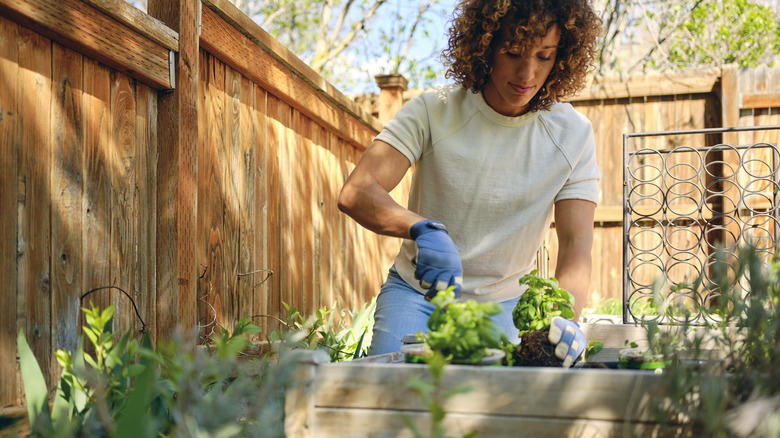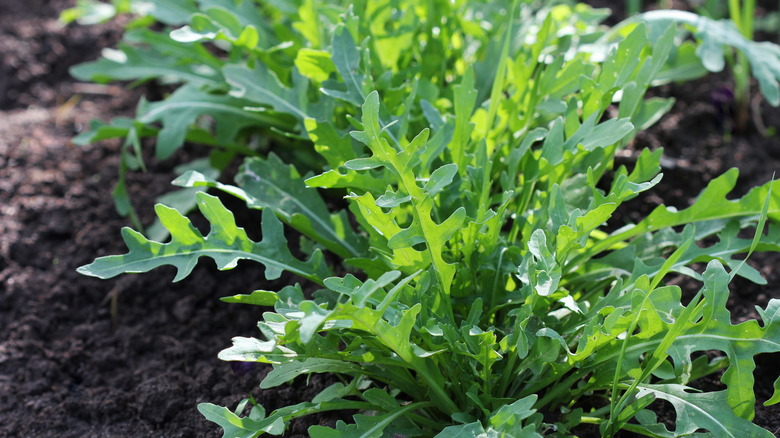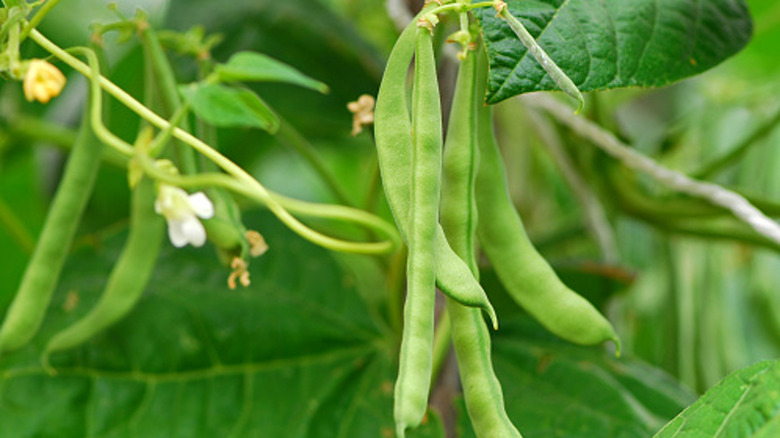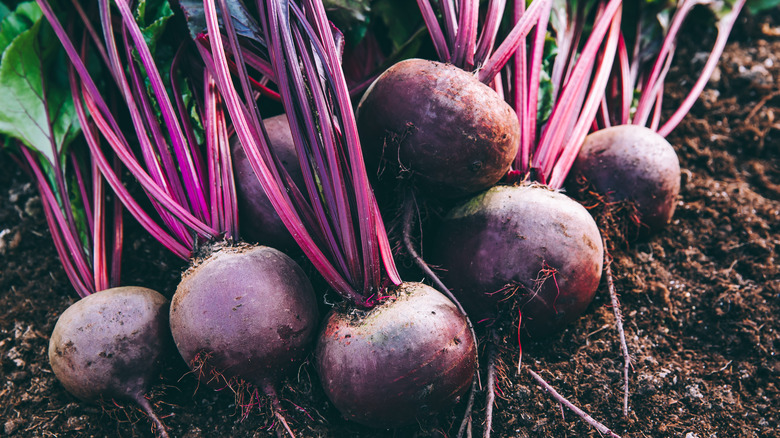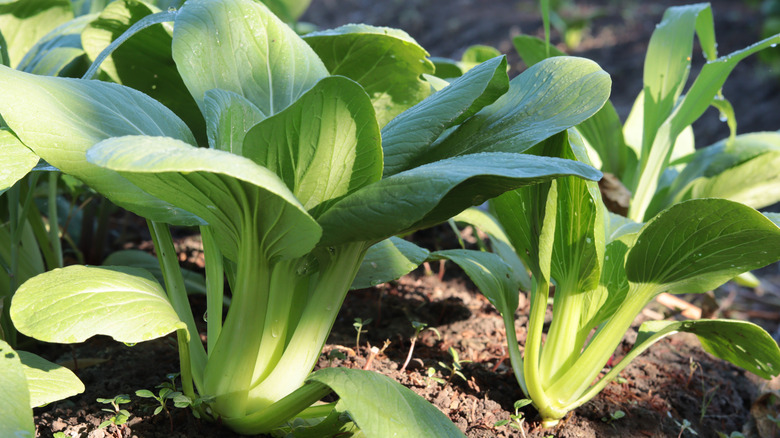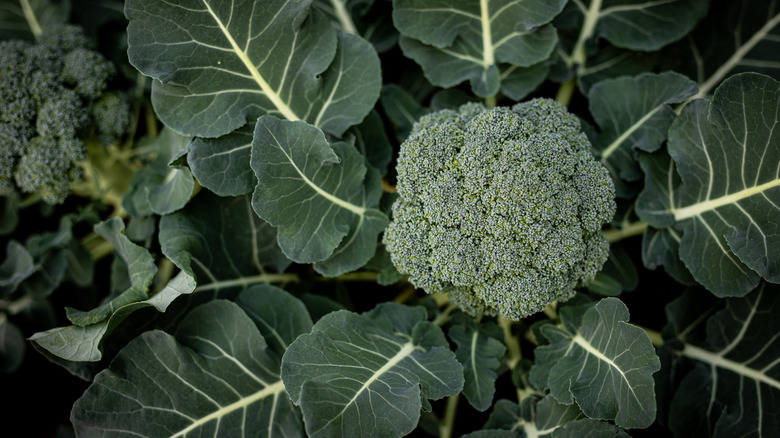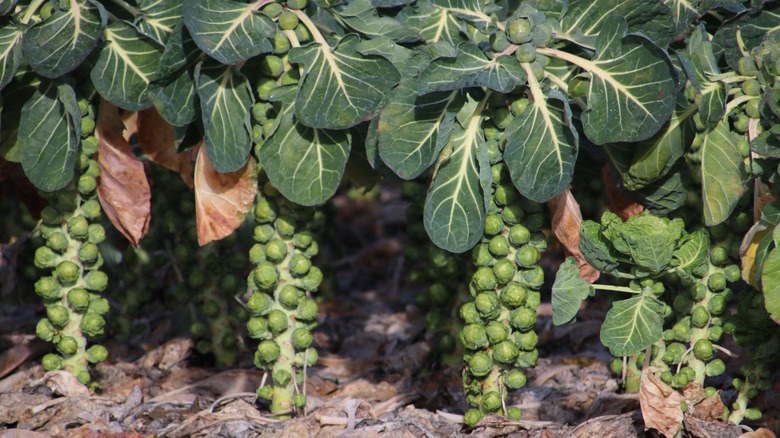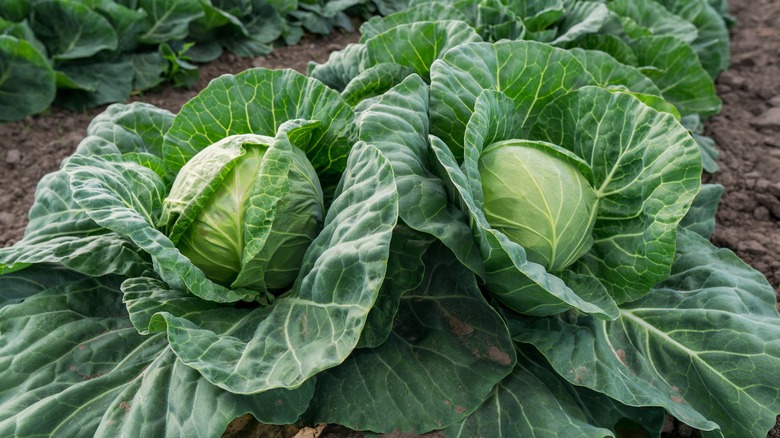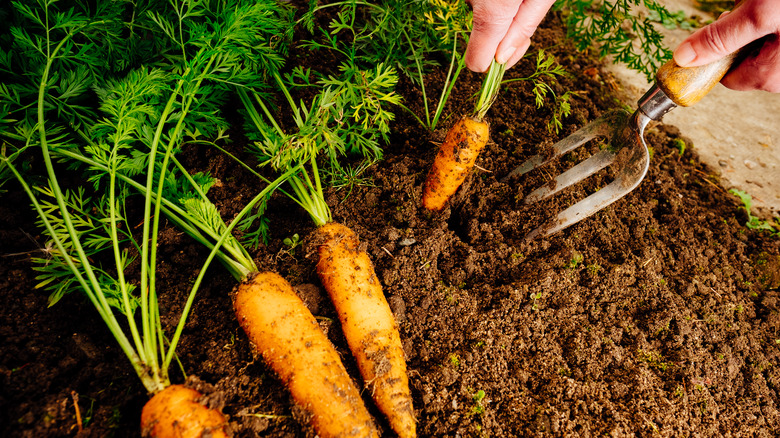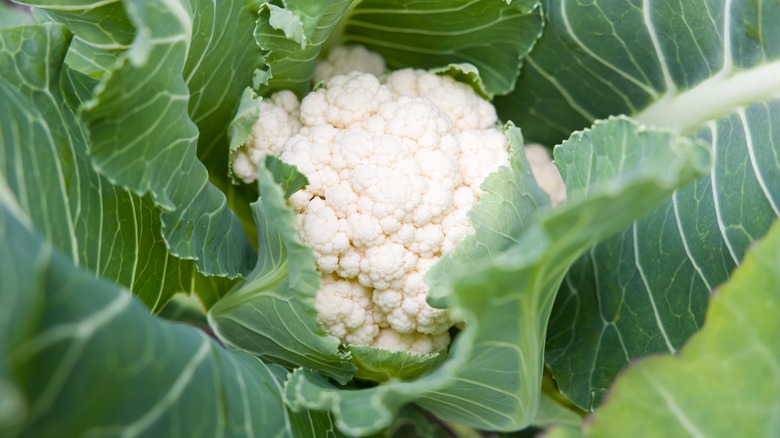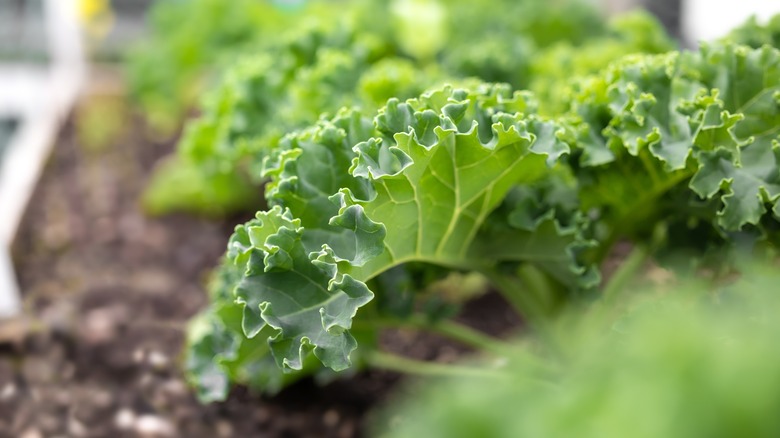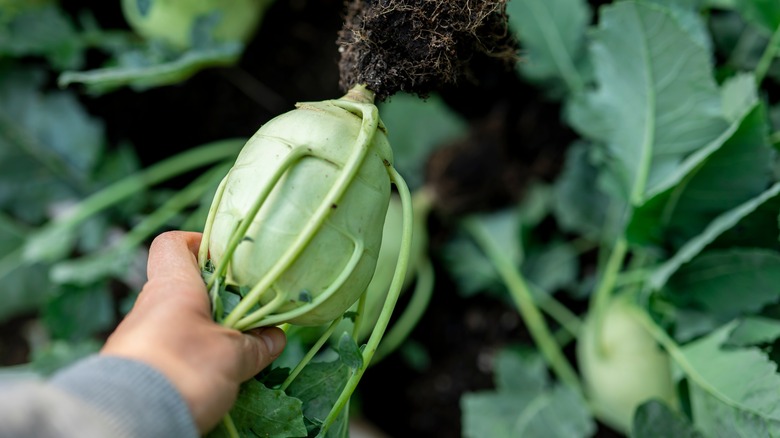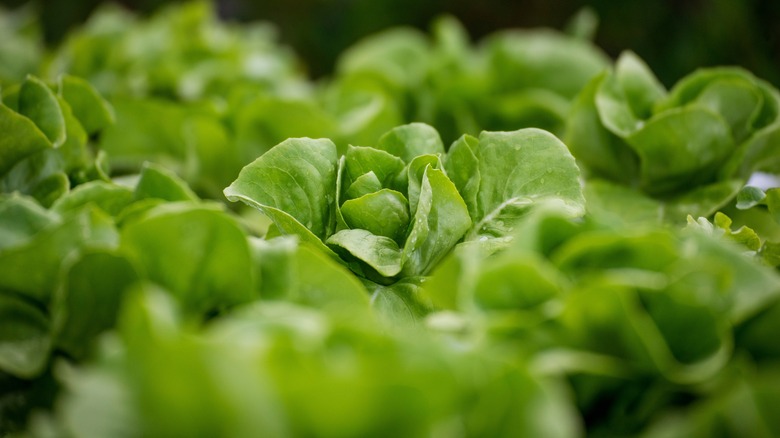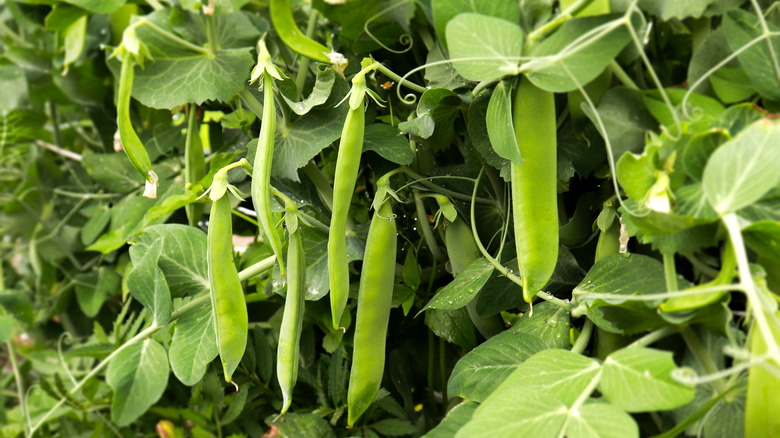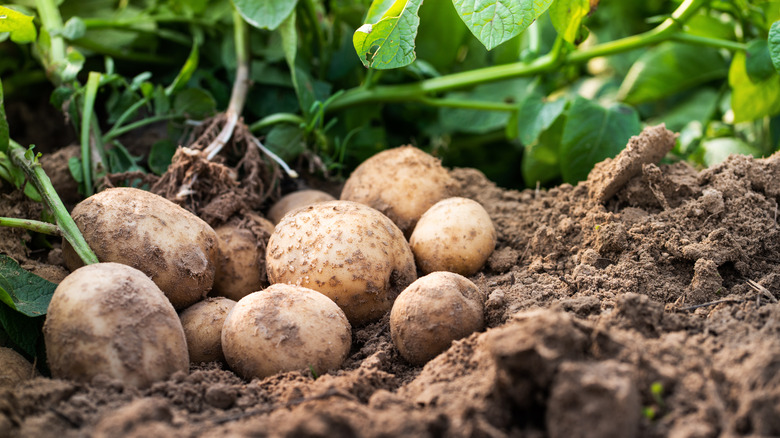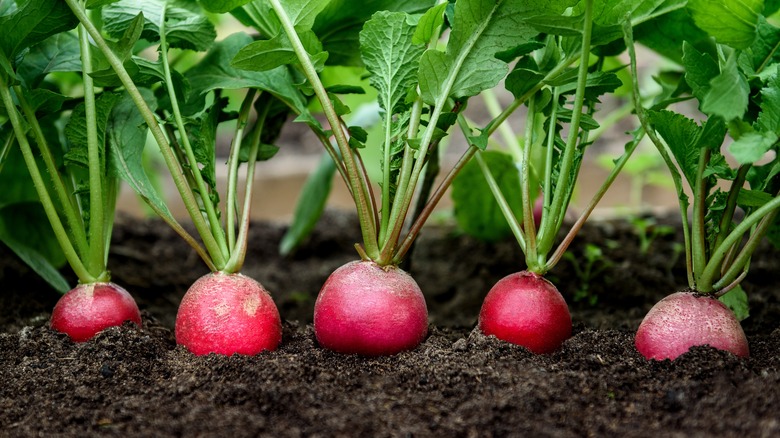These Vegetables Absolutely Thrive In The Shade
When you think about growing plants in your garden, you might imagine them basking in sunshine all day long. While there are certain vegetables that are sun-hungry and can handle the heat, there are plenty of others that would instead grow in the shade. If you have a dark spot in your yard that you thought wasn't useful to you as a gardener, you'll be thrilled to find out that it might be the perfect place to grow a range of veggies.
Of course, not all shade is the same. A spot that's covered by a tree but still has some sunlight peeking through receives what is known as light or dappled shade. If an area gets around 3 hours of full sun each day, that's partial shade. Although you might think that full shade is a place that's always in the dark, it's actually a section that doesn't quite get 3 hours of sunlight a day and spends the rest of the time in dappled shade. Some of these plants may also need partial sun, which is 3 to 6 hours of light a day. Being completely covered in shade throughout the entire day is known as deep shade, and vegetables won't grow in these conditions because every plant needs at least a little light. For instance, the following veggies tolerate only partial sun and shade and will not tolerate only dappled shade or full shade, so ensure they get more than 3 hours of light.
Arugula (Eruca sativa)
If you grow arugula in your garden, then it's good to know that it will appreciate full sun, but only if the temperature is on the cool side. Otherwise, arugula will grow quickly and heartily in partial sun for around 6 hours a day. If they end up getting too many rays during the day, you'll be left with leaves that taste icky and bitter. So you'll want to give your arugula plants plenty of shade so they can grow to be healthy and tasty. These greens grow best in USDA hardiness zones 2-11 in cooler seasons.
Green beans (Phaseolus vulgaris)
Green beans are another veggie that only desires a few hours of sun each day, as they do require some light to grow their flowers and eventual pods. Green beans can thrive with just 4 to 5 hours of sun and grow in the USDA hardiness zones 3-10. If they get too much sun, they'll also get more heat than they need. This results in the plants withering and perhaps even dying. Instead, give your green beans shade, which will keep them relatively cool and allow them more time to grow throughout the season.
Beets (Beta vulgaris)
Beets are a vegetable that does well in the shade and can also stand up to freezing weather. Ideal in USDA hardiness zones 2-10, you'll want to plant beets as winter ends and spring sweeps into town. Although the temperature may still be on the cooler side, and you won't have as much sunlight as you might in the summer, the spring conditions will be perfect for growing beets in your shady garden. Beets can take longer to mature with 4- 5 hours of sun a day, however, in part shade, it can help to prevent bolting.
Bok choy (Brassica rapa, subsp. chinensis)
When you plant bok choy in your garden, you should expect to end up with a vegetable that produces delicious leaves that boast a rich flavor. For the best yield, grow in partial shade with only about 3 to 5 hours of sun a day in USDA hardiness zones 4-7. Because of bok choy's dependence on shade, you can grow it in a container or planters. If you find that they're getting too much sun, you can simply move the container to a spot that's cool and shady.
Broccoli (Brassica oleracea, variety italica)
Broccoli is another popular and tasty vegetable that you can grow in a shady place on your property, specifically in USDA hardiness zones 3 to 10. Although they may need up to 6 hours of sun at times, they can also be grown in partial shade, they will thrive in a shady area that will stay cooler. When you harvest the first head of broccoli that grows from each center, leave the remaining parts of the plant right where they are in the shade. This will result in additional heads growing on the stem.
Brussels sprouts (Brassica oleracea, variety gemmifera)
Brussels sprouts may not always be a crowd-pleasing veggie. But if you are fond of them, then you know that they can have a sweet taste. Of course, if you grow your own Brussels sprouts, then you should plant them in a relatively cool spot in your garden that gets quite a bit of shade. It's ideal to grow Brussels sprouts in USDA hardiness zones 2 to 10 for at least 5 hours in partial sun. The cooler air will help the Brussels sprouts develop the sweet flavor that you're looking for when you cook them up.
Cabbage (Brassica oleracea, variety capitata)
Gardeners will end up with the kind of cabbage that neighbors envy if they grow it in cool weather and in a spot that gets a fair bit of shade. Cabbage is best planted in hardiness zones 1 to 9, and although it can handle about 6 hours of sunlight in your garden if necessary, you may prefer to keep your cabbage in partial shade as much as possible. This is especially true when summer hits its peak, and the temperatures rise while the sunlight also becomes more intense which can harm the veggies.
Carrots (Daucus carota, subsp. sativus)
You might assume that it doesn't matter where you grow carrots because they grow underground. Of course, only part of the carrot — the section that you eat — is within the dirt. The greenery stretches above the ground and doesn't always appreciate being baked in the sun. In partial shade grown in USDA hardiness zones 3-10, carrots only require around 4 hours of sunlight to still yield a good harvest. Instead, offer your carrots moderate shade along with loose soil that's well-drained and rich in nutrients.
Cauliflower (Brassica oleracea, variety botrytis)
When growing cauliflower, you have to pay particular attention to the temperature. This tasty vegetable is notoriously picky and doesn't do well when exposed to extreme heat. This is why it's important to grow this cruciferous veggie in the shade. This will ensure that your yield is bountiful and will help stop the heads from experiencing tarnishing and flowering early due to too much exposure to the sun. Cauliflower can take up to 6 hours of partial sun in USDA hardiness zones 7-10 planted in cooler weather so it can thrive before the summer heat.
Kale (Brassica oleracea, variety acephala)
Kale is a cool plant in more than one way. Not only is it rich in calcium, iron, and vitamins A, B6, and C, but it also does best when grown in cooler temperatures and can handle less than 6 hours of sun in partial shade. Kale grows best in USDA hardiness zones 8 to 10, but be mindful when taking care of this veggie because if the plant is exposed to too much sunshine in the growing phase, it will result in bitter leaves, which is not a welcome taste at the dinner table.
Kohlrabi (Brassica oleracea, variety gongylodes)
For those not familiar with the kohlrabi, it has a similar taste profile to that of a turnip but with less of a bite and a touch more sweetness. But one thing that can change the final taste of this iron-rich vegetable is extreme sunshine, which is why it can thrive in 6 hours of partial sunlight. Best planted in hardiness zones 3-10, too much sun can cause the plant to seed prematurely in a process called bolting. This can result in a less-than-flavorful crop and one that stops producing too soon.
Lettuce (Lactuca sativa)
Beautifully crunchy lettuce can be easy to grow in your backyard in USDA hardiness zones 4-9 when kept in the right conditions. 4 to 6 hours of partial shade, in particular, can be your best friend when cultivating your crop. The cooling properties of the shade can help moderate the temperature of the soil and extend the life of the lettuce roots, which, in turn, will ensure your lettuce stays alive longer. Temperature also plays an important role in the harvesting process, as picking lettuce leaves in the morning can ensure a crunchier, moist taste.
Peas (Pisum sativum)
Peas are the kind of vegetable that needs a fair amount of protection and TLC during the growing stages. Best grown in hardiness zones 3-11 with 4 to 5 hours of partial sunshine, this vitamin C and E-rich vegetable grows rapidly in cooler temperature seasons with support from a trellis as well as plenty of shade from the sun's rays. Too much exposure to the hot sun can result in wilted or even burnt leaves. Excessive heat can also dry out the soil of your peas and affect the moisture content, which can alter the overall production.
Potatoes (Solanum tuberosum)
Potatoes can do well in the sun partly because they partially grow underground. However, nothing is stopping you from planting these popular root vegetables in the shade. Especially if you are looking to grow a smaller type of spud that's perfect for side dishes, those grown in partial shade with slight sun exposure for up to 6 hours will give you more undersized tubers than ones grown in direct sunshine. Potatoes thrive in USDA hardiness zones 1-7 in cooler soil temperatures from 45 to 55 degrees Fahrenheit being the optimal range.
Radishes (Raphanus sativus)
Although radishes may not be the favored choice for all folks, these root vegetables have numerous healthy properties in the bulb and the leaves themselves. To get the most out of your radish crop and to make certain that the plants don't go through premature bolting, it's wise to keep them in the shade. Best grown in USDA hardiness zones 2-10 with up to 6 hours of partial sun a day. With a proper amount of cover, you will help to prevent the mature radish from becoming too spongy, which could occur with over-exposure to the sun.
